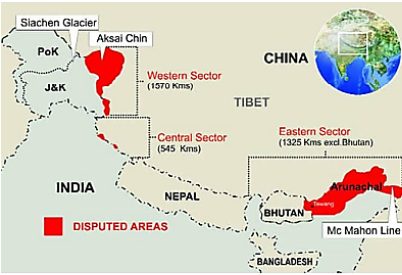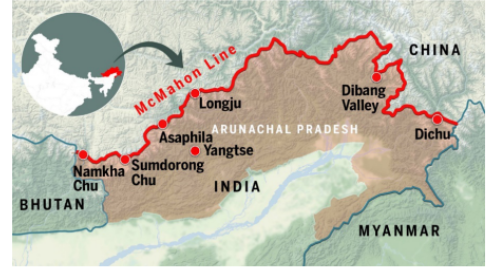Important for
Prelims: International Relations
Mains: General Studies Paper II
WHAT IS THE MCMAHON LINE
- Two United States Senators, have introduced a bipartisan resolution in the upper chamber of Congress reiterating that the US recognizes the McMahon Line as the international boundary between China and India .
- The McMahon Line serves as the de facto boundary between China and India in the Eastern Sector.

- It specifically represents the boundary between Arunachal Pradesh and Tibet, from Bhutan in the west to Myanmar in the east.
- China has historically disputed the boundary and claims the state of Arunachal Pradesh as part of the Tibetan Autonomous Region (TAR). When was it drawn:
- The McMahon Line was drawn during the Shimla Convention of 1914, officially described as the Convention Between Great Britain, China, and Tibet.
- China was represented at the convention by the government of the Republic of China, which was in power in the mainland from 1912 to 1949.
- The McMahon Line delimited the respective spheres of influence of Tibet and British India in the eastern Himalayan region in what is today India’s Northeast and northern Myanmar. The border in this region was undefined prior to the signing of the convention.

- The McMahon Line serves as the de facto boundary between China and India in the Eastern Sector.
- It specifically represents the boundary between Arunachal Pradesh and Tibet, from Bhutan in the west to Myanmar in the east.
- China has historically disputed the boundary and claims the state of Arunachal Pradesh as part of the Tibetan Autonomous Region (TAR). When was it drawn:
- The McMahon Line was drawn during the Shimla Convention of 1914, officially described as the Convention Between Great Britain, China, and Tibet.
- China was represented at the convention by the government of the Republic of China, which was in power in the mainland from 1912 to 1949.
- The McMahon Line delimited the respective spheres of influence of Tibet and British India in the eastern Himalayan region in what is today India’s Northeast and northern Myanmar. The border in this region was undefined prior to the signing of the convention.
WHAT HAPPENED AT THE SHIMLA CONVENTION OF 1913-14?
- The convention attempted to settle the question of Tibet’s sovereignty and avoid further territorial disputes in the region.
- The treaty divided the Buddhist region into “Outer Tibet” and “Inner Tibet” – the former would “remain in the hands of the Tibetan Government at Lhasa under Chinese suzerainty”, though China was not allowed to interfere in its affairs.
- The latter would be under the direct jurisdiction of the newly formed Republic of China.
- The latter of these newly decided boundaries would later be called the McMahon Line after McMahon, the chief British negotiator.
WHY CHINA DID NOT SIGN THE CONVENTION:
- Arguing that Tibet had no independent authority to enter into international agreements.
- How was the border between British India and China decided?
- Following the “highest watershed principle”. This principle, considered to be the most logical way of drawing borders in mountainous regions by the British, basically drew the border along the highest ridge between two river plains. Status of the McMahon line since 1914:
- After the communists took power in 1949, they pulled China out of all international agreements and the so-called “unequal treaties”.
Practice Questions for Prelims
Consider the following statements and choose the correct options :
1. McMohan Line defines the border between India and Pakistan.
2. Japan is working with India on High speed rail with India on High Speed rail projects.
3. Japan is allowed to invest in strategically sensitive North-East India.
Correct Options :
a) 1 only
b) 2 only
c) 2 and 3 only
d) All of the above
Ans. c)




Leave a Reply
You must be logged in to post a comment.